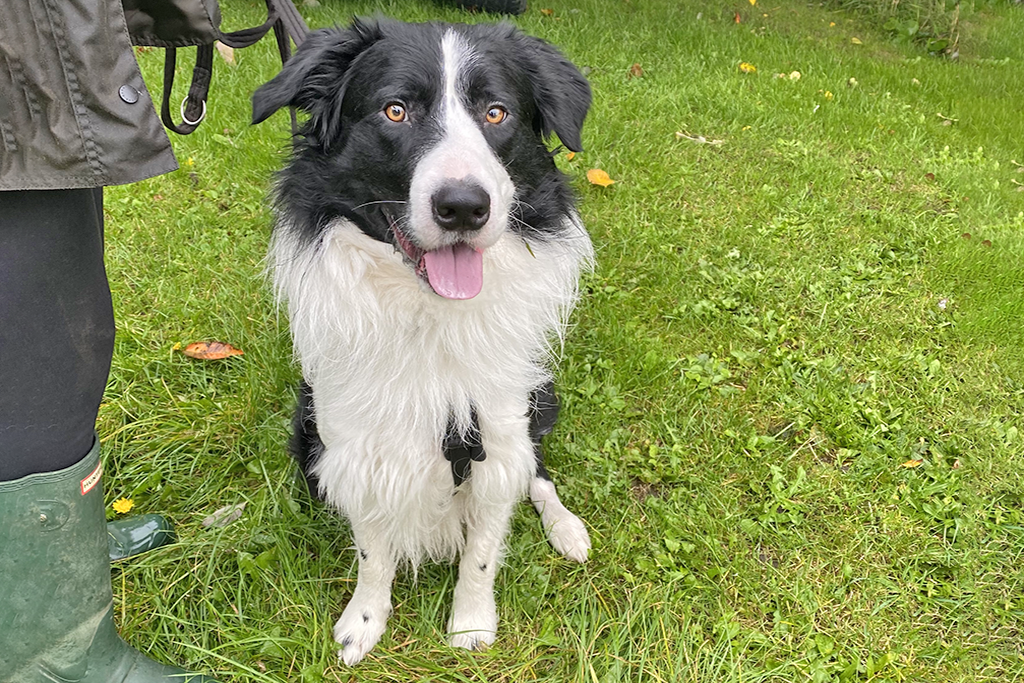
Max is a 2.5 year old, gorgeous, big (27kg) border collie who came to us for help with border collie lead reactivity with other dogs. He enjoyed the company of other dogs until he was about a year old, when he started to get a series of unfriendly greetings from other dogs that he met while out walking in his village. Unfortunately, he has learned from this that every time he makes a lot of noise, barking and lunging, the scary dogs keep walking past and he doesn’t have to deal with dogs barking and growling at him. Having a lead on, although important to ensure that there are no injuries, doesn’t help the dog, because not only is he afraid, but he also knows that if he needs to run away, he can’t. Therefore, faced with fight or flight, with the “flight” option taken away, he is only left with “fight”.
The best way to deal with lead reactivity in border collies caused by fear (a very common issue) is to change the dog’s association with other dogs from being scary into starting to associate other dogs with something nice happening. The best way to do this is by using two processes together, called desensitisation and counter-conditioning.
Desensitisation/Counter-conditioning (DS/CC) for border collie lead reactivity
Desensitisation is: a very steady process of gradually exposing the lead reactive dog to the scary thing, beginning at a very low level and building up incrementally to increase the exposure with the trigger object (in this case, other dogs). In this way, Max will learn that other dogs can be around but that they stay at a safe distance and that nothing bad happens, even when he is not barking, growling or lunging.
The vital part of this process is determining at what distance Max would need to be from his trigger (other dogs) to ensure that he remained under the threshold at which the unwanted behaviour will start, and able to cope. Once dogs have become so aroused that they exceed their threshold, they are no longer able to take in what is happening properly and learn. For learning to take place, it’s important to keep the dog calm. Max’s owners were taken through a process of observing Max’s body language to ensure that they understood the distance at which Max would need to be kept from other dogs in order to feel safe.
Counterconditioning involves changing how the dog automatically feels about, and responds to, something. In this case, Max is currently panicking and feeling fearful and anxious when another dog approaches. Using counterconditioning, we can change his feelings of fear and anxiety to interest and even excitement that something good is about to happen whenever he sees another dog. We are talking here about involuntary reactions, not behaviours. It’s Max’s feelings about other dogs that we are aiming to change, not his behaviour. But by keeping Max at a safe distance from other dogs so that he doesn’t feel the need to practise barking and lunging, we are also teaching him that the problem behaviour is not necessary for him to feel ok and so his behaviour will change by default.
Keeping Max free from close encounters with other dogs
The only way that the processes of desensitisation and counter-conditioning will work is if Max is not put into a position in which he will need to practise the behaviour. That means keeping him away from any other dogs while out walking and ensuring that he doesn’t meet any suddenly, such as round a corner or in a shop. He needs to always be at his safe distance so that he feels secure.
Over time, as the processes start to work, Max’s safe distance will change so that he can be nearer and nearer dogs without feeling afraid. So gradually Max will enable to tolerate and even come to enjoy passing dogs in the street, if the owners are meticulous in following the training plan.
Alongside helping Max overcome his fears using DS and CC, we also showed his owners how to use games that they can use at the same time to improve the situation even further.
Games to help Max
Lesley McDivitt’s Control Unleashed program includes a series of games that are designed to help reactive dogs. There is strong evidence that when dogs are fearful, engaging them in pattern behaviours and games that they enjoy that are already associated with happy feelings, can add an extra boost to the DS/CC work that we’ll be doing. Border collies, particularly, are masters of noticing patterns. It enables them to predict what’s happening and feel safe. These are, therefore, great games to teach Max that we can start to use in the presence of other dogs to help change his fearful associations and will be a help in any unplanned encounters that Max may have with other dogs while working on this program.
With previous trainers, Max’s owners were taught to try and get Max’s attention away from the scary thing (dogs) and onto them so that he didn’t react. At the same time, they would tell him “no” to try and stop the behaviour.
There are 2 big problems with this:
- When a dog is scared and very wound up, about the presence of another dog, he is extremely unlikely to want to look away from it. After all, the scary thing may suddenly leap at him, like it did before, and he needs to be ready for that.
- Telling a dog off or asking him to look away does not change his fear response to the other dog, in fact, it is likely to make him even more fearful.
We will teach Max’s owners three fun games to train Max, which they will use alongside the DS/CC work, all of which will work together to change Max’s associations with, and reactions to, other dogs from one of fear and reactivity to pleasure and enthusiasm. We’ll include further details of how these games can help in another blog post.
After the first session, Max’s owners went away understanding the concepts, committed to the training and eager to start the process of changing Max’s feelings towards other dogs. We’ll continue to keep in contact to see how things progress!
Update:
We recently received the following update from Max’s owners:
“Max Update! We took Max out last weekend and he only barked at one little dog that came out of nowhere and wouldn’t move. His barking and lunging have 90% stopped and we can get his attention if not too close.”
Well done guys!!


My girl reacts to other dogs with lunging and pulling and barking .She is 6 months old and it is with reluctance that we take her out of the yard .She previously had a bad expywith another BC where she was let off and my fed at the puppy who ve she threatened and bit her and then it became an aggressive fight .
Will this impact Meg so much so that it will be very hard to now try to socialise her .
Hi Karin, yes these sorts of incidents can, unfortunately, have a big impact on young collies, particularly if they occur during the fear periods which are roughly at 12-16 weeks and then again from about 6-18 months. The behaivour processes you now need to work through are counterconditioning and desenstisation, which will only work if carried out at a distance from other dogs at which she feels safe. It’s very important that you prevent her from practising the behaviour; the more that she performs the behaviour, the more she will continue to practise it.
Hey there, great article! As an expert, I totally agree that understanding and training Border Collies with lead reactivity and aggression towards other dogs is crucial for a well-behaved and happy pup.
Hi there, thanks for the really informative article.
I have a border collie, I used to consider myself a bit of an expert, having rehabilitated and trained many abused and abandoned dogs without issue. This border collie was gotten off a farm and has really strong working line.
At first my training with him went amazing, he was the friendliest most submissive pup loved other dogs and people. Then around 6months he had to be flown to another country by my husband.
Since then (he’s nearly 3 now) he’s become reactive to waiters and very snappy at other dogs, I’ve tried so many different training techniques but in America people don’t control their dogs so he’s become terrified also of being bitten around the crotch so has become extremely reactive everytime a dog sniffs him.
Any advice?
I’ve tried slow controlled socialisation and controlled reward based activities. But he would rather play with me rather than other dogs or he just becomes reactive.
Its sad because he obviously wants to say hi occasionally.
Hi Mary, that’s such a shame – it sounds like he found the flight traumatic and it’s left him with fears that he didn’t previously have. This is unfortunately very common.
With waiters, is he able to be taken into a restuarant or pub when there aren’t waiters around? If he can, then find a pub with a nice big garden or one with big rooms with lots of space, and sit somewhere where he can be quite a way from the waiter when he/she comes over. As soon as you see them approach, start to feed him treats, one after the other in quick succession until the waiter has gone. Do the same if anyone at all comes near your table. The key is to keep the treats coming until the waiter has gone. over time, this starts to change your dog’s emotional reaction to people approaching the table, so instead of worrying about it, they start to look forward to it. And they therefore react less. My dog was the same and now after two years of doing this on the rare occasion that we take her out with us to eat, we have absolutely no reaction at all and we no longer have to use treats. If he can’t cope with being in pubs and continues to react even when you’re feeding him treats then that will be a longer process that I can’t really go into in this reply, but I’ll try and do a blog post about it.
With reaactivity towards other dogs, this article might help:https://collieconsultant.co.uk/2022/10/18/border-collie-aggression/. But keep watching the blog and I will shortly write an article about dog-dog aggression as well! Thank you for commenting and reminding me. 🙂
Hi, I’ve got a 5 year old border collie cross welsh sheepdog. She is really well behaved in the home but once she knows she is going for a walk she starts barking. When out she calms a little but when walking past other dogs or even just people she starts barking and nothing I do stops it. She sounds very aggressive but she’s not . I am at my wits end with her . I just don’t know what to do. Thanks Lesley
Hi Lesley, I’m so sorry I didn;t see this until now. Try having a read through this article – it may help: https://collieconsultant.co.uk/2023/11/11/border-collie-aggressive-behaviour-what-do-i-do/
Even though he may be feeling frustrated rather than fearful, the training outlined in this article should still help.